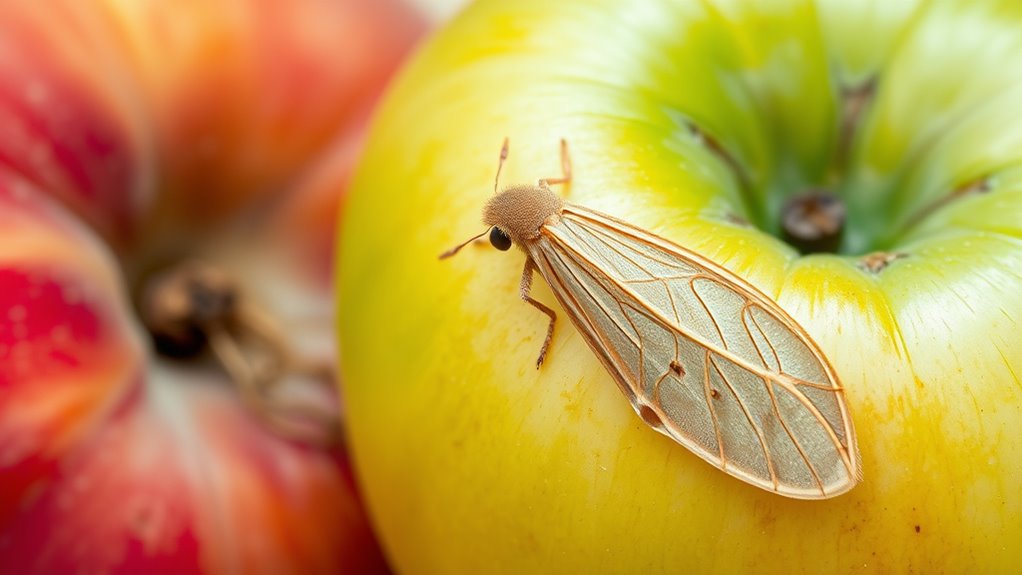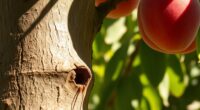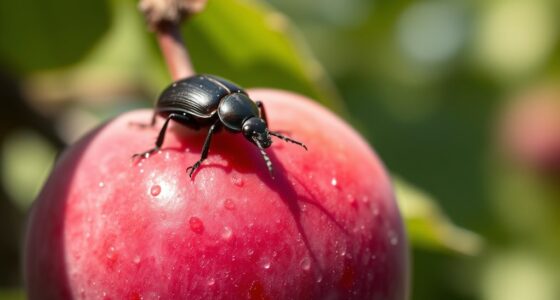The Oriental Fruit Moth affects peaches and apples by laying eggs on the fruit or shoots. Once the eggs hatch, larvae tunnel into the fruit, causing deformities, premature drop, and lowering crop quality. Effective management involves early detection with pheromone traps, biological controls like Trichogramma wasps, and cultural practices like sanitation and pruning. Using physical barriers and monitoring timing help reduce damage. If you keep exploring, you’ll discover practical strategies to manage this pest sustainably.
Key Takeaways
- Oriental Fruit Moth targets peaches and apples, causing fruit distortion, premature drop, and reduced yields.
- Adults are small, brown, active at dusk, and lay eggs on fruit or shoots, leading to larval tunnels inside fruit.
- Monitoring with pheromone traps and early detection of egg hatch are essential for effective control.
- Biological controls like Trichogramma wasps and organic sprays during early larval stages help manage populations.
- Cultural practices such as orchard sanitation, pruning, and physical barriers reduce moth habitat and infestation risk.

If you’re growing peaches or apples, you need to be aware of the Oriental Fruit Moth, a pest that can cause significant damage to your crop. This pest targets your fruit during multiple stages of development, often resulting in distorted fruit, premature drop, and reduced yields. To protect your orchard, effective pest management is essential, and incorporating organic control methods can help you maintain a healthy, sustainable environment.
Protect your peaches and apples from the damaging Oriental Fruit Moth with effective organic pest management.
The key to managing the Oriental Fruit Moth is early detection and targeted intervention. Adult moths are small, brown, and active at dusk, often flying around trees before laying eggs on the fruit or shoots. Once eggs hatch, larvae burrow into the fruit, creating tunnels that make the fruit unmarketable and susceptible to secondary infections. Regular monitoring, such as pheromone traps, can help you identify when moth populations are increasing, allowing you to time your control measures effectively.
When it comes to pest management, integrating organic control techniques offers a safe and environmentally friendly approach. One effective method is the use of biological agents like Trichogramma wasps, which parasitize moth eggs, reducing their hatch rate. Applying insecticidal soaps or neem oil during the early larval stages can also help suppress larval populations without harming beneficial insects. Additionally, introducing or encouraging natural predators such as certain types of parasitic wasps and predatory beetles can create a balanced ecosystem that keeps pest numbers in check.
Cultural practices are also crucial in organic control. Regularly removing fallen and infested fruit minimizes the chances of larvae completing their development and spreading further. Pruning dense canopies improves air circulation and sun exposure, making your orchard less hospitable for moths and their larvae. Using sticky traps and barriers can physically prevent adult moths from reaching fruit clusters, reducing egg-laying opportunities.
Timing is critical in pest management. Applying organic controls at the right life stages—typically when eggs are hatching or larvae are emerging—maximizes their effectiveness. Combining these strategies with consistent orchard sanitation and vigilant monitoring creates a complete approach, reducing reliance on chemical pesticides and supporting sustainable fruit production. By staying proactive with organic control methods and pest management practices, you can safeguard your peaches and apples from the damaging effects of the Oriental Fruit Moth, ensuring a healthy, productive harvest year after year.
Frequently Asked Questions
How Can I Distinguish Oriental Fruit Moth Damage From Other Pests?
You can distinguish oriental fruit moth damage by looking for visual signs like small, sunken areas on fruit and larval tunnels beneath the skin. These tunnels are often winding and may cause fruit to drop prematurely. Unlike other pests, the damage tends to be concentrated near the blossom end, and frass (insect excrement) may be visible inside the tunnels. Regular scouting helps catch infestations early.
What Natural Predators Help Control Oriental Fruit Moth Populations?
Think of natural predators as your orchard’s silent allies. Beneficial insects like Trichogramma wasps and parasitic mites act as biological control agents, helping keep Oriental Fruit Moth populations in check. These helpful bugs target eggs and larvae, reducing the need for chemical treatments. By encouraging their presence through habitat management, you support a balanced ecosystem that naturally suppresses pest outbreaks, promoting healthier, more resilient fruit trees.
Are There Resistant Peach or Apple Varieties to This Moth?
You’ll find that some resistant cultivars and pest resistant varieties are available for peaches and apples, which can help reduce Oriental Fruit Moth damage. These cultivars are bred specifically to withstand or repel the moth, minimizing the need for chemical controls. When selecting your fruit trees, look for varieties labeled as resistant or pest resistant, and combine their use with other integrated pest management strategies for the best results.
How Does Weather Influence Oriental Fruit Moth Outbreaks?
Weather patterns and temperature fluctuations greatly influence oriental fruit moth outbreaks. Warm, mild conditions accelerate moth development and increase the number of generations per season. Conversely, sudden temperature drops or harsh weather can suppress their activity, reducing damage. You should monitor weather forecasts closely, as consistent warm temperatures and specific humidity levels create ideal environments for moth proliferation. Adjust your pest management strategies accordingly to stay ahead of potential outbreaks.
Can Organic Methods Effectively Manage Oriental Fruit Moth?
Yes, organic methods can effectively manage oriental fruit moths. You should use organic sprays like neem oil or Bacillus thuringiensis to target larvae and prevent damage. Additionally, trap methods such as pheromone traps help monitor and reduce moth populations. Regularly inspecting your trees and combining these strategies increases your chances of controlling this pest naturally, promoting healthier fruit without synthetic chemicals.
Conclusion
As you protect your orchard from the oriental fruit moth, remember that each healthy fruit symbolizes hope and perseverance. Your efforts are the shield guarding this delicate balance between nature’s bounty and its challenges. With every cautious step, you nurture resilience and growth, turning your orchard into a sanctuary of life. Let your dedication be the light that guides your trees through the darkness, ensuring they flourish and remind us all of nature’s enduring spirit.









